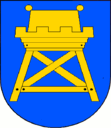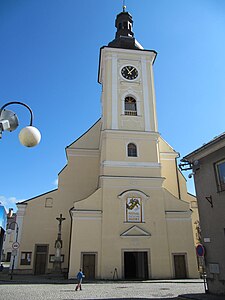Odry
| Odry | ||||
|---|---|---|---|---|
|
||||
| Basic data | ||||
| State : |
|
|||
| Region : | Moravskoslezský kraj | |||
| District : | Nový Jičín | |||
| Area : | 7408 ha | |||
| Geographic location : | 49 ° 40 ′ N , 17 ° 50 ′ E | |||
| Height: | 274 m nm | |||
| Residents : | 7,227 (Jan 1, 2019) | |||
| Postal code : | 742 35-742 38 | |||
| License plate : | T | |||
| traffic | ||||
| Street: | Fulnek - Hranice | |||
| Railway connection: | Suchdol nad Odrou – Budišov nad Budišovkou | |||
| Next international airport : | Ostrava Airport | |||
| structure | ||||
| Status: | city | |||
| Districts: | 9 | |||
| administration | ||||
| Mayor : | Libor Helis (as of 2014) | |||
| Address: | Masarykovo náměstí 16/25 742 35 Odry |
|||
| Municipality number: | 599701 | |||
| Website : | www.odry.cz | |||
Odry ( German Odrau ) is a town in Okres Nový Jičín in the Czech Republic .
geography
The city is located in Moravia, 15 kilometers northwest of Nový Jičín ( Neu Titschein ) on the Oder and is in the south of the Oder Mountains on both sides of the river in the Oder valley before it flows into the Kuhländchen .
The Pohoř ( Pohorschberg , 475 m) rises to the south-east . The state road I / 47 leads through the city from Ostrava ( Ostrau ) to Hranice ( Mährisch Weißkirchen ), from which the II / 441 leads to Potštát ( Bodenstadt ) on the northern outskirts .
Neighboring towns are Vítovka in the north, Tošovice ( Taschendorf ), Hvězdová ( Sternfeld ) and Jestřabí ( Jastersdorf ) in the northeast, Pohoř ( Pohorsch ) in the east, Mankovice ( Mankendorf ) in the southeast, Emauzy ( Emaus ) and Vražné ( Petersdorf ) in the south, Veselí ( Wessiedel ) in the south-west, Dvořisko ( Hennhof ) and Dobešov ( Dobischwald ) in the west and Nová Ves ( Neudörfel ) and Loučky ( Lautsch ) in the north-west.
history
The village of Vyhnanov , located on the left bank of the Oder on the Pohoř mountain , was first mentioned in a document in 1234 when the Tišnov monastery was founded by Ottokar II Přemysl . The Moravian town, which was owned by the Cistercian monastery, perished in 1241 when the Golden Horde invaded . To protect against further Tatar invasions, a permanent castle was built on the Oder around 1253. This castle on the border between Moravia and Silesia became the seat of the Odra rulership, the first proven owner of which is the Burgrave of Olomouc, Albert von Sternberg .
Below the castle, a village was built on the right side of the Oder, which was named Odra or Oderaw . It was first mentioned on February 15, 1346, when the Opava Duke Nicholas II inherited the village of Odra to Zbyňek von Tworkau , who was probably a son of the Opava provincial judge Andreas / Ondřej von Tworkau, who was documented in 1288.
In 1357 the Sternbergers founded the town according to Troppauer law. At the end of the 14th century, a border dispute arose over the Odra rulership, which originally belonged to the Troppauer Land , which was to be inserted into the Moravian land table in Olomouc in 1480, like the Fulnek rulership before . On October 28, 1481, the Opava Duke Viktorin and the representatives of the Moravian estates, Bishop Protasius and Governor Ctibor von Cimburg , compared the fact that the Oder should form the border between the Duchy of Opava and the Margraviate of Moravia and that the Odra rule should be part of the The Duchy of Troppau remained. To settle the ongoing dispute, a new border was drawn between Moravia and Silesia in 1493, which was declared binding by Emperor Matthias in 1613 and which lasted until 1920. The city belonged to Austrian Silesia until the founding of Czechoslovakia .
Between 1428 and 1435 Odra was a seat of the Hussites . In the following time the noble families von Krawarn , Oderski von Liderau, Zwolsky von Zwole , Praschma , Werdenberg, Lichnowsky von Woschütz and Schlabrendorf became . Under the rule of the Prashma, the Reformation took place in 1553 and Odra remained Protestant until 1627. In 1602 a plague epidemic broke out and the Thirty Years War led to the decline of the city, which by then had developed into an important trading center. Towards the end of the 17th century, the city had recovered from the consequences of the war and the subsequent imperial administration of the confiscated rule. Since that time the city has been known as Odrau . In 1691 the St. Bartholomew Church was rebuilt.
In 1730 Leopold Franz Freiherr von Lichnowsky had the baroque palace built in place of the Gothic castle complex. Mining for lead and silver ores began in 1747 and was discontinued in 1796. Around 1750 the cloth factory was established in Odrau. In 1774 a wool goods factory was established. At the beginning of the 19th century, the Fürstenbergs acquired the Odrau rule. Charlotte Landgravine von Fürstenberg in particular gave the city special support. The palace park was created in 1833.
After the removal of patrimonial in 1848 Odrau became an independent city. In 1866 a rubber goods factory was founded. With the commissioning of the local line Zauchtel-Bautsch in 1891 Odrau received a railway connection. The city was the seat of a judicial district in the political district of Neutitschein . In 1900 it included the city of Odrau, the 16 communities Dobischwald , Dörfel, Heinzendorf , Groß-Hermsdorf , Klein Hermsdorf , Jogsdorf , Kamitz , Kunzendorf, Lautsch , Mankendorf, Neudörfel , Klein Petersdorf , Taschendorf, Werdenberg , Wessiedel, and Schlesisch Wolfsdorf.
In 1930 Odrau had 4,000 inhabitants, of which 3,461 were Germans. After the Munich Agreement , Odrau was added to the German Reich and occupied by the Wehrmacht on October 10, 1938. The persecution of Jewish citizens and those with political dissent followed. Until 1945 Odrau was assigned to the district of Neu Titschein , district of Troppau , in the Reichsgau Sudetenland .
The castle was owned by the Counts Potocki until 1945 . The approximately 4000 German inhabitants of Odrau were expelled after the end of the Second World War in 1945/46. On January 17, 1964, 80% of the castle was destroyed by fire. The ruins were ceremoniously blown up on July 7, 1966 and a concrete department store was built in their place.
Demographics
| year | Residents | Remarks |
|---|---|---|
| 1900 | 4.191 | German residents |
| 1930 | 4,000 | |
| 1939 | 4.134 |
Local division
The town of Odry consists of the districts Dobešov ( Dobischwald ), Kamenka ( Kamitz ), Klokočůvek ( Klein Glockersdorf ), Loučky ( Lautsch ), Pohoř ( Pohorsch ), Tošovice ( Taschendorf ), Veselí ( Wessiedel ) and Vítovka ( Werdenberg ) and the localities Dvořisko ( Hennhof ), Hvězdová ( Sternfeld ), Kolonka ( colony ) and Nová Ves ( Neudörfel ).
Attractions
- Bartholomäuskirche, the baroque building was built in 1691–1692 in place of a previous Gothic building from 1373. In the tower there is a bell from 1374, which is considered the oldest preserved church bell in Moravia.
- Neoclassical fountain on Masarykovo náměstí ( market square ), created in 1897 by the sculptor Emil Zimmermann and consecrated as the Emperor Franz-Josefs-Brunnen
- Marian column on Masarykovo náměstí, created in 1783
- Statue of St. John of Nepomuk from 1714, originally standing on the Johannis Bridge
- Statue of St. Florian placed between the church and the rectory on Masarykovo náměstí, 1751
- Attractions in Odry
sons and daughters of the town
- Heinrich Jan Demel (1808–1867), Austrian astronomer and mathematician
- Josef Fiebiger (1870–1956) Austrian university professor
- Walter Galuschka (1921–1967), German politician (SPD), MdL Bavaria
- Eduard Gerlich (1836–1904), engineer and professor in Zurich, the railway construction technician created the plans for the construction of railway lines in the Austrian and Swiss Alps
- Wilhelm Heinz (* 1894; † unknown), engineer, politician (NSDAP) and member of the German Reichstag
- August Herzmansky (1834–1896) Austrian businessman and founder of the Herzmansky department store in Vienna
- Karl Alfons Jurasky (1903–1945), geologist, born in Lautsch
- Alois Klein (1836–1927), judiciary reformer in Croatia-Slavonia
- Gustav Kreitner (1847–1893), Austrian geographer, diplomat and Asian researcher
- Ernst Lohwag (1847–1918), German writer, born in Dobischwald
- Anton Rolleder (1855–1912), professor at the Steyr State Realschule and local historian, made an honorary citizen in 1904
- Ferdinand Ulrich (1931–2020), German philosopher
- Horst Vladar (* 1941), German director, singer and artistic director of the Neuburg Chamber Opera
- Otto Walzel (1919–1991), German politician (SPD, CDU), MdL Rhineland-Palatinate
- Emil Zimmermann (1861–1928), Austrian sculptor
literature
- Joachim Bahlcke , Winfried Eberhard and Miloslav Polívka: Handbook of historical places : Bohemia and Moravia. Kröner's pocket edition 329. Kröner, Stuttgart 1998, ISBN 978-3-520-32901-1
- Walther Mann (Ed.): Memories of Odrau. Volumes 1, 2 and 3, Darmstadt 1999-2007
- Anton Rolleder: History of the city and the judicial district Odrau. 1903
Web links
- Description of the city on kuhlaendchen.de
- Former Baroque Odry Castle ( Czech )
- Memories of Odrau Volume I (PDF; 13.9 MB)
- Memories of Odrau Volume II (PDF; 4.6 MB)
- Memories of Odrau Volume III (PDF; 4.5 MB)
Individual evidence
- ↑ Český statistický úřad - The population of the Czech municipalities as of January 1, 2019 (PDF; 7.4 MiB)
- ↑ Jiří Stibor: Genealogy Pánů for Tvorkova . In: Časopis Slezského Zemského Muzea, No. 1, 2004, pp. 18–40
- ↑ Odrau . In: Meyers Großes Konversations-Lexikon . 6th edition. Volume 14, Bibliographisches Institut, Leipzig / Vienna 1908, p. 909 .
- ↑ a b Michael Rademacher: German administrative history from the unification of the empire in 1871 to the reunification in 1990. Neu Titschein district. (Online material for the dissertation, Osnabrück 2006).





